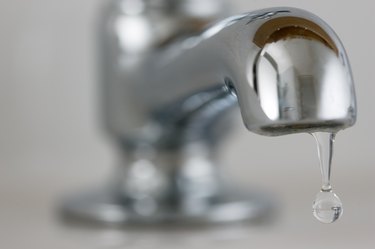Speedy Methods for Limited Water Pressure in Your Home
Speedy Methods for Limited Water Pressure in Your Home
Blog Article
The writer is making a few good points on the subject of 10 Reasons for Low Water Pressure in Your House as a whole in this content below.

Low tide stress in your house can be an irritating trouble, influencing every little thing from showering to washing recipes. If you're experiencing weak water flow, there are a number of feasible reasons and options to discover. In this overview, we'll review typical reasons for low water stress and practical actions to resolve the issue effectively.
Intro to Low Tide Pressure
Low water stress happens when the circulation of water from your faucets, showers, and other components is weaker than typical. This can make everyday jobs much more tough and much less efficient. Comprehending the sources of low water pressure is crucial to finding the best solution.
Usual Reasons For Low Water Stress
Faulty Pressure Regulatory Authorities
Pressure regulatory authorities are accountable for maintaining consistent water stress in your house. If they malfunction, it can lead to low tide pressure or unequal circulation throughout your house.
Municipal Supply Of Water Issues
Often, the issue exists outside your home. Municipal water system problems, such as main line leakages or upkeep work, can briefly minimize water stress in your location.
Pipeline Obstructions
In time, pipes can come to be obstructed with mineral deposits, debris, or particles, restricting the flow of water. This is a typical issue in older homes with galvanized steel pipelines.
Corrosion
Corrosion within pipelines can cause leaks and lowered water stress. Rust buildup can tighten water flow, especially in maturing plumbing systems.
Just How to Diagnose Low Tide Stress
Checking Pipelines
Examine visible pipes for indications of leaks, rust, or clogs. Pay attention to any type of uncommon audios, such as banging or rattling pipes, which can suggest problems within the plumbing system.
Consulting with a Plumber
If you're incapable to pinpoint the root cause of low water pressure, take into consideration employing a specialist plumber to carry out a detailed examination. They can determine underlying issues and suggest suitable options.
Checking Taps and Fixtures
Start by examining the water stress at different faucets and fixtures throughout your home. If the problem is separated to certain locations, it may suggest localized problems.
Do It Yourself Solutions to Deal With Low Tide Stress
Flushing Water Heater
Sediment buildup in the water heater can restrict circulation and decrease performance. Purging the storage tank regularly assists remove debris and maintain optimal performance.
Checking Stress Regulatory Authority
Guarantee that the pressure regulatory authority is functioning properly. Readjusting or changing the regulator can help recover correct water stress throughout your home.
Cleaning Aerators and Showerheads
Mineral deposits can collect in aerators and showerheads, decreasing water flow. Eliminate and clean up these parts routinely to improve water pressure.
Cleaning Clogs in Water Lines
For small obstructions, attempt utilizing a plumbing serpent or chemical drain cleaner to clear obstructions in pipes. Be cautious when utilizing chemicals and comply with safety and security standards.
When to Call an Expert Plumber
If do it yourself initiatives fall short to solve the concern or if you suspect considerable plumbing issues, it's best to look for support from an accredited plumber. They have the competence and devices to attend to complex issues safely and successfully.
Preventive Measures to Keep Water Stress
Installing a Pressure Booster
Think about mounting a stress booster pump to boost water stress in areas with consistently reduced flow. This can be particularly helpful for multi-story homes or residential properties with high-demand components.
Surveillance Water Use
Bear in mind water use habits and avoid ill-using the plumbing system. Easy changes, such as shocking showers and washing loads, can help maintain sufficient water pressure.
Regular Upkeep
Arrange routine maintenance for your plumbing system to stop problems such as deterioration, leaks, and clogs. Attending to minor problems early can aid prevent even more significant repairs later on.
Verdict
Handling low tide stress can be discouraging, but identifying the underlying causes and executing proper solutions can recover optimum flow throughout your home. Whether it's cleaning aerators, checking pipelines, or seeking advice from a plumber, taking aggressive actions can make sure a stable supply of water for your daily demands.
FOUR WAYS TO FIX LOW WATER PRESSURE NOW
Turning on a shower or faucet only to find the water comes out in a sad, slow drizzle is never a good feeling. How exactly are you supposed to wash a pan or take a quick shower when it takes 10 minutes just to rinse off a little soap? The good news is that when your water pressure is bad, there's always a cause: typically one that can be easily fixed. Here are some of the most common causes of low pressure and what you can do to fix the issue:
DEBRIS AND MINERAL DEPOSIT BUILDUPS
If you notice low water pressure from just one or two of the fixtures in your house, the problem likely has to do with debris buildup. Water is full of minerals and other debris, all of which can accumulate in your pipes and on your fixtures. This can cause a blockage that affects how much water flows through. To fix this, try filling a small plastic bag with white vinegar, and use a rubber band to hang it around your showerhead or faucet. Let the head of the fixture soak for a few hours, and the vinegar should loosen the deposits.
WATER LEAKS
Leaks are another common cause of low water pressure. If water is flowing out of your plumbing through a hole or crack before it can reach your fixture, the pressure coming out of the faucet or showerhead will be lower. A plumbing professional is your best bet for finding and repairing a leak in your water supply pipes.
Leaks are another common cause of low water pressure. If water is flowing out of your plumbing through a hole or crack before it can reach your fixture, the pressure coming out of the faucet or showerhead will be lower. A plumbing professional is your best bet for finding and repairing a leak in your water supply pipes.
A VALVE ISSUE
If you have low water pressure throughout your home, check your main shut-off valve to make sure it's completely open. You may also want to see if there's a pressure-reducing valve installed. If there is, have a plumber help you adjust the settings to get the pressure you're looking for.
OTHERS USING WATER
Believe it or not, your low water pressure could be caused by your neighbors. If you notice low pressure at certain times of day, it may be because you and the people living next to you have similar schedules - when everyone is showering at the same time, the pressure will be lower in every home. Low pressure throughout the neighborhood may also be caused by an issue with your municipal water supply. If that's the case, call the supplier to see if they're working on the issue.
https://www.rotorooter.com/blog/water-leaking/low-water-pressure-fixes/

As an avid reader on 9 Reasons for Low Water Pressure in Your House, I think sharing that piece of content was really useful. Do you know anybody else who is truly interested in the niche? Why not share it. Thank-you for going through it.
Free Quote Report this page